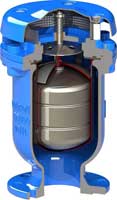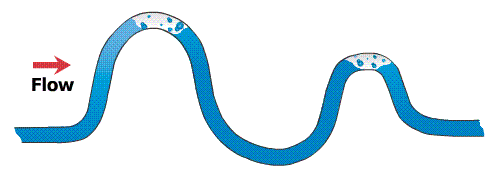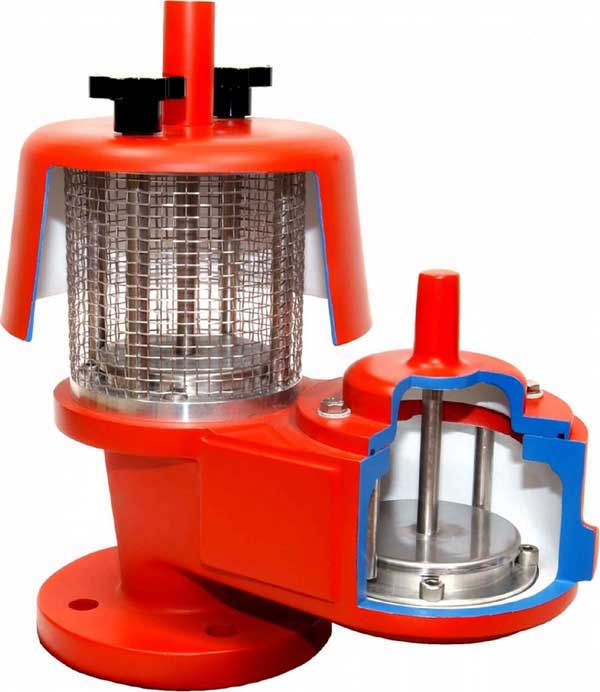 |
Air valves and their essential function |
Air valves play a crucial role in pumping stations and pipelines. They ensure proper flow of water and wastewater, and essentially allow a system to breathe when necessary.
Typically, these automatic Air valves allow air to escape from the system, but during a pump failure, an Air valve can allow air into the pipeline to prevent damage from a vacuum.
Air valves are installed at local high points to allow air to flow into the system when the pressure drops below the level of the pipe system and to remove air from the system when liquid columns reconnect.
The presence of air in the piping system limits the subatmospheric pressure in the vicinity of the valve and over a certain distance on either side of it. Air can also reduce high transient pressures if it is sufficiently compressed to slow down the liquid columns before impact.
- Pressure below atmospheric pressure.. the Air valve is open and ensures that the pressure on the upstream side remains at 0 and that the flow on the upstream and downstream sides remains equal.
- Pressure above atmospheric pressure.. the Air valve is closed and acts as a node.



Types of Air valves
Butterfly valves
Butterfly valves are widely used in HVAC systems to control airflow. They consist of a round disc
or blade that rotates on a shaft, allowing the valve to be opened or closed when turned. Butterfly
valves are known for their compact design, fast response, and low pressure drop. They are suitable
for applications where space is limited and precise flow control is required.
Check valves
check valves, also known as one-way valves, are designed to prevent backflow in a system. They allow
air to flow in one direction only, ensuring that the system operates efficiently and prevents contamination.
Check valves are commonly used in HVAC systems, pneumatic equipment, and industrial processes where
maintaining the integrity of the system is critical. They are available in various designs, such
as swing check valves, lift check valves, and ball check valves, each offering different advantages
and applications.
Solenoid valves
Solenoid valves are electromechanical devices that use an electromagnetic field to control the opening
and closing of the valve. They are often used in pneumatic systems to control the flow of compressed
air. Solenoid valves are available in various configurations, such as normally open or normally
closed, and can be remotely controlled using electrical signals. They offer precise control and
fast response times, making them ideal for applications that require rapid and accurate control
of air flow.
Where should Air valves be installed?
Maximum high points
Air bubbles accumulate and form air pockets that become trapped at the highest points in the system.
By installing Air valves here, the air pockets can be discharged into the atmosphere.
Long ascending or descending pipe sections
Loose air bubbles can flow downstream and form larger air bubbles in the upper part of the pipe.
Rapid flow in downward sloping pipe sections can also create a vacuum. As a rule of thumb, air
vent valves and air vacuum valves should be installed every 800 meters on long pipe systems to
properly vent the system and draw in air.
Temporary high points
Local high points can also serve as collection points for air bubbles. An air vent allows the air
bubbles to escape into the atmosphere.
Functions of Air valves
Pressure control
Air valves help maintain desired pressure levels in a system by opening or closing in response to
pressure changes. This is crucial in applications where maintaining a specific pressure range is
essential for the proper operation of equipment or processes. In pneumatic systems, for example,
it is necessary to maintain the correct pressure to ensure the efficient operating principle of
pneumatic tools and machines.
Airflow control
Air valves regulate the air flow in a system and ensure that it is distributed evenly and efficiently.
By adjusting the opening and closing of the valve, the flow rate can be regulated to meet the specific
requirements of the application. This is particularly important in HVAC systems, where maintaining
the desired temperature and comfort level depends on the proper distribution of conditioned air.
System protection
Air valves play a crucial role in protecting the system from damage caused by excessive pressure
or flow. By monitoring and regulating the air flow, valves can prevent system overload or overpressure,
which could lead to equipment failure or damage. Check valves are specifically designed to prevent
backflow and protect the system from contamination by ensuring that air flows in only one direction.
Energy efficiency
Properly functioning Air valves contribute to the overall energy efficiency of a system by regulating
airflow and maintaining optimal pressure. By ensuring that the system operates within its designed
parameters, Air valveS help reduce energy consumption and minimize waste, leading to cost savings
and a smaller environmental impact.
In summary: Air valves are essential components in various applications and perform important functions such as flow control, pressure control, system protection, and energy efficiency. Understanding the role of Air valves in different systems is crucial for optimizing performance and ensuring reliable operating principles.
Remark(s) of the Author...
Additional information
After writing this article, a good friend sent me the link below: https://www.environmental-md.com/blog/the-importance-of-air-valves
I was pleasantly surprised by the content, and added some text and useful animated images from that website.
...So how does air negatively impact a system? Pockets of air accumulating at high points can result in a restriction which causes increased velocity as well as increased head. This will also increase energy consumption. Air pockets can also promote corrosion of pipe and fittings.


...If we know the application will have low pressure ahead of time, we can accommodate for this, so the right valve ends up in the field, and there are no potential leaking issues.


I hope that the owner of that website will appreciate this brief summary of his or her article.
Related Post(s)

Breather Valves, also known as direct acting Pressure/Vacuum Relief Valves, are special types of Relief Valves which...